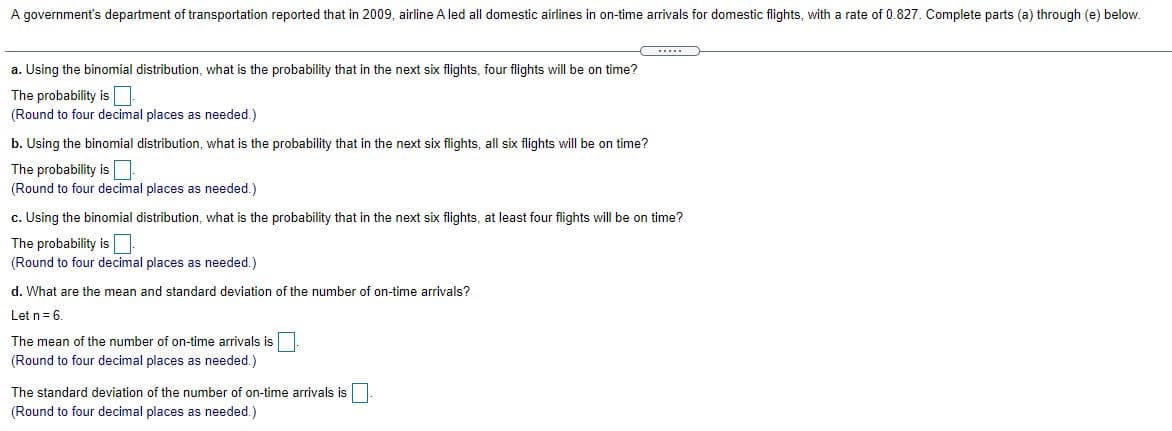A government's department of transportation reported that in 2009, airline A led all domestic airlines in on-time arrivals for domestic flights, with a rate of 0.827. Complete parts (a) through (e) below. a. Using the binomial distribution, what is the probability that in the next six flights, four flights will be on time? The probability is (Round to four decimal places as needed.) b. Using the binomial distribution, what is the probability that in the next six flights, all six flights will be on time? The probability is (Round to four decimal places as needed.) c. Using the binomial distribution, what is the probability that in the next six flights, at least four flights will be on time? The probability isO (Round to four decimal places as needed.)
A government's department of transportation reported that in 2009, airline A led all domestic airlines in on-time arrivals for domestic flights, with a rate of 0.827. Complete parts (a) through (e) below. a. Using the binomial distribution, what is the probability that in the next six flights, four flights will be on time? The probability is (Round to four decimal places as needed.) b. Using the binomial distribution, what is the probability that in the next six flights, all six flights will be on time? The probability is (Round to four decimal places as needed.) c. Using the binomial distribution, what is the probability that in the next six flights, at least four flights will be on time? The probability isO (Round to four decimal places as needed.)
Chapter8: Sequences, Series,and Probability
Section8.7: Probability
Problem 11ECP: A manufacturer has determined that a machine averages one faulty unit for every 500 it produces....
Related questions
Question

Transcribed Image Text:e. What assumption(s) do you need to make in (a) through (c)? Select all that apply.
O A. The outcome of any observation is dependent of the outcome of any other observation.
B. The outcome of any observation is independent of the outcome of any other observation.
O C. The probability of an observation being classified as the event of interest, z, is constant from observation to observation.
O D. Each observation is classified into one of two mutually exclusive and collectively exhaustive categories.

Transcribed Image Text:A government's department of transportation reported that in 2009, airline A led all domestic airlines in on-time arrivals for domestic flights, with a rate of 0.827. Complete parts (a) through (e) below.
a. Using the binomial distribution, what is the probability that in the next six flights, four flights will be on time?
The probability is
(Round to four decimal places as needed.)
b. Using the binomial distribution, what is the probability that in the next six flights, all six flights will be on time?
The probability is
(Round to four decimal places as needed.)
c. Using the binomial distribution, what is the probability that in the next six flights, at least four flights will be on time?
The probability is
(Round to four decimal places as needed.)
d. What are the mean and standard deviation of the number of on-time arrivals?
Let n= 6.
The mean of the number of on-time arrivals is
(Round to four decimal places as needed.)
The standard deviation of the number of on-time arrivals is
(Round to four decimal places as needed.)
Expert Solution
This question has been solved!
Explore an expertly crafted, step-by-step solution for a thorough understanding of key concepts.
Step by step
Solved in 4 steps with 3 images

Knowledge Booster
Learn more about
Need a deep-dive on the concept behind this application? Look no further. Learn more about this topic, statistics and related others by exploring similar questions and additional content below.Recommended textbooks for you

